
The breast wall of a glass furnace is a core refractory structure that ensures the efficient operation, structural stability, energy conservation, and long-term safety of the furnace. It withstands the most severe high-temperature, chemical, and mechanical environments, supports the large arch, seals the high-temperature melting space, and provides a window for operation monitoring. Its performance and lifespan directly affect the overall operational efficiency, glass quality, energy consumption level, and production cost of the glass furnace, making them key focus areas for furnace maintenance and material selection. Over the years, the flat glass industry in various countries has made significant progress in process technology, production equipment, and product quality, with the service life of glass furnaces also being significantly extended. However, in glass furnaces, the problem of the breast wall in the melting section tilting inward has gradually become prominent, becoming a major challenge affecting the stable operation of the furnace, and even forcing some manufacturers to suspend production for cold repair.
This article starts with an in-depth analysis of the root causes of the inward inclination of the chest wall, and then delves into the crucial role of fused cast AZS blocks in the breast wall of the glass furnace and the improvement strategies, to provide useful references for the stable development of the glass production industry.
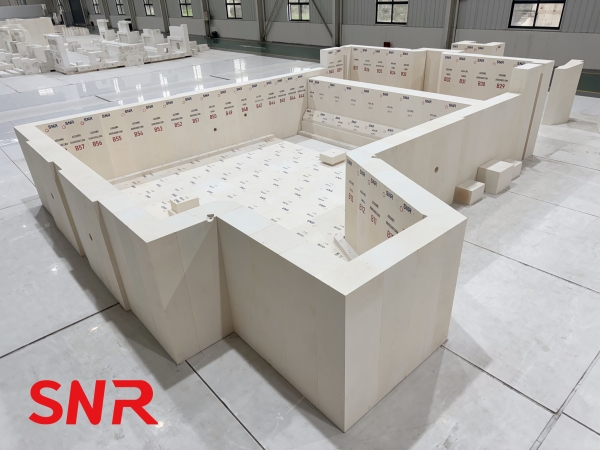
The inward inclination phenomenon of the breast wall in the glass furnace and impact
The inward inclination of the breast wall in a glass furnace refers to the phenomenon where, under the long-term effects of high temperature, load, and chemical erosion, the upper part of the breast wall gradually tilts inward (towards the direction of the molten pool) within the furnace. This phenomenon can lead to serious consequences: it disrupts the tight structure between the breast wall and the crown, causing abnormal stress in the arch top, loosening of the arch blocks, and an increased risk of collapse; it causes cracks in the refractory brick joints, resulting in leakage of high-temperature gases, increased heat loss, and overheating damage to the external steel structure; it squeezes the flame space, interfering with the stability of combustion and the efficiency of heat transfer, affecting the quality of glass melting; and it accelerates its erosion, significantly shortening the lifespan of the furnace, and is one of the key structural defects threatening the safe and stable operation of the furnace.
In-depth analysis of the causes of inclination of the breast wall in the glass furnace
The inclination of the breast wall in a glass furnace is a complex structural deterioration problem resulting from the long-term combined effect of multiple factors. The main causes can be summarized as follows:
Material creep under high-temperature conditions and the effect of load
This is the fundamental physical mechanism of the inward inclination. The refractory materials of the breast wall undergo significant changes in their physical properties when they are exposed to the extremely high temperatures (usually > 1500°C) in the continuous operation of the furnace. Under the action of high temperature and constant stress (mainly the huge static load transmitted from the large arch), the material will undergo thermal creep. Creep refers to the slow and continuous plastic deformation of the material when the stress is lower than its short-term strength limit over time. The breast wall is constantly subjected to the huge weight of the large arch (vertical pressure) and the lateral thrust generated by the arch structure. This continuous stress state induces the slow flow and deformation of the material under high temperatures, causing its structure to gradually tilt inward (the direction of stress release). The longer the time, the higher the temperature, and the greater the load, the more significant the creep deformation. This deformation is usually irreversible.
Complex and intense thermal stress shock
The operation of glass furnaces inevitably undergoes cold and hot cycles, such as ignition and oven heating, planned shutdowns, accidental shutdowns for insulation, or daily temperature fluctuations. The thermal expansion coefficient of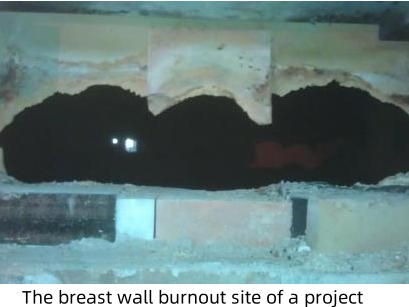 refractory materials is not infinitely large. During rapid temperature changes, different parts of the abutment (inside and outside, top and bottom) will generate huge thermal stresses due to the temperature gradient and different heating/cooling speeds. This repeated thermal stress cycle will cause microcracks to form inside the material and gradually expand (thermal shock damage). More importantly, during the heating or cooling process of the oven, if the temperature rise/fall curve is improperly controlled, resulting in a large temperature gradient or local overheating, it will cause uneven expansion or contraction inside the abutment structure, forming strong internal stress, which will drive the structural deformation. Long-term accumulation of thermal stress fatigue will significantly weaken the strength and stiffness of the material, exacerbate its creep deformation trend under high-temperature loading, and promote the occurrence and development of internal inclination.
refractory materials is not infinitely large. During rapid temperature changes, different parts of the abutment (inside and outside, top and bottom) will generate huge thermal stresses due to the temperature gradient and different heating/cooling speeds. This repeated thermal stress cycle will cause microcracks to form inside the material and gradually expand (thermal shock damage). More importantly, during the heating or cooling process of the oven, if the temperature rise/fall curve is improperly controlled, resulting in a large temperature gradient or local overheating, it will cause uneven expansion or contraction inside the abutment structure, forming strong internal stress, which will drive the structural deformation. Long-term accumulation of thermal stress fatigue will significantly weaken the strength and stiffness of the material, exacerbate its creep deformation trend under high-temperature loading, and promote the occurrence and development of internal inclination.
Potential defects in design, construction, and maintenance
►Design factors: The design of the breast wall structure is unreasonable. For instance, the reserved expansion joints are insufficient or improperly positioned, failing to effectively absorb thermal expansion, resulting in excessive thermal stress; the supporting structure of the arch foot bricks has insufficient strength, unable to effectively restrain the lateral thrust of the arch roof; the selection of refractory materials is inappropriate, as their high-temperature creep rate, thermal shock resistance, and alkali erosion resistance cannot meet the actual operating conditions of this furnace.
►Masonry quality: Problems such as excessive or insufficient brick joints during construction, incomplete mud filling, uneven mortar joints, unorganized brick arrangement, poor verticality control, etc. These issues will reduce the overall structural strength and are prone to becoming stress concentration points and weak links under high temperatures, triggering deformation. The masonry accuracy at key locations (such as the junction between the arch foot bricks and the abutment wall) is particularly important.
►Operation and maintenance: Inappropriate operating procedures for the furnace, such as excessively high melting temperatures, frequent or drastic temperature fluctuations, unstable furnace pressure control (excessive positive pressure intensifies erosion and gas leakage), improper flame adjustment (flames scouring the breast wall), etc., will accelerate the damage and inward inclination of the breast wall. Failure to promptly detect and address small cracks, erosion points, or structural loosening during daily maintenance can also lead to the accumulation and worsening of problems.
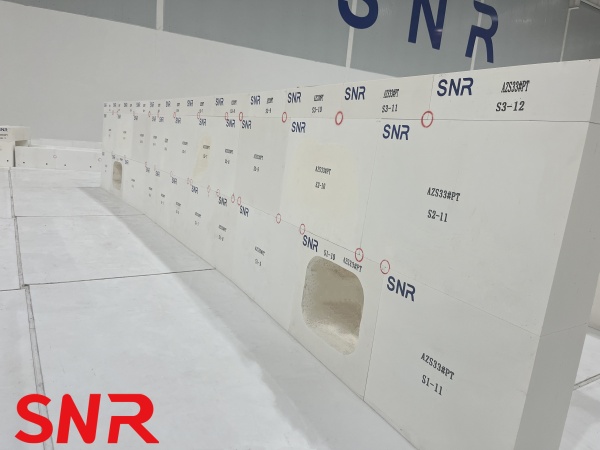
In summary, the inward inclination of the abutment is the result of the long-term and collaborative effects of multiple factors such as high-temperature creep, thermal stress fatigue, chemical erosion deterioration, and potential design/construction/maintenance defects. High-temperature loading provides the driving force for creep; thermal stress cycles cause damage accumulation; chemical erosion fundamentally weakens the mechanical properties of the material; and deficiencies in design, construction, and maintenance may act as catalysts or weak links that accelerate this process. These factors are interrelated and mutually reinforcing, ultimately leading to the progressive tilting deformation of the abutment structure towards the furnace interior.
The application and advantages of fused cast AZS blocks in the breast wall of the glass furnace
The characteristics and advantages of fused cast AZS blocks
Fused cast AZS blocks, as a type of refractory material produced through the electric melting process, possess high melting points, high strength, excellent thermal shock resistance, and resistance to chemical erosion. In glass furnaces, fused cast AZS blocks are commonly used in key areas such as breast wall and sidewalls to withstand the erosion of high-temperature glass liquid and thermal stress. Compared to traditional refractory materials, fused cast AZS blocks have a longer service life and better stability, effectively reducing the occurrence of problems like inward tilting of abutments.
The current application status and challenges of fused cast AZS blocks
At present, glass manufacturers both at home and abroad widely use fused cast AZS blocks in the breast walls of their furnaces to enhance the refractory performance and stability of the chest walls. However, in practical applications, fused cast AZS blocks still encounter some challenges. For instance, the compatibility between the fused cast AZS blocks and the surrounding materials may cause stress concentration and cracking during use; construction quality issues, such as excessive mortar joints and loose brick joints, can also affect the sealing and stability of the chest walls. Moreover, the thermal stress generated during the operation of the furnace is an important factor leading to the cracking or detachment of the fused cast AZS blocks.
Measures for dealing with the inward inclination of the breast wall and improvement strategies for fused cast AZS blocks
1. Active intervention measures for the inward inclination of the breast wall
Structural reinforcement and mechanical correction
By strengthening the horizontal pull bar system of the furnace and installing hydraulic jacks on key columns, applying reverse mechanical tension to the breast wall to restrain its continuous inward inclination; at the same time, welding and reinforcing the support structure of the arch foot beam to disperse the lateral thrust transmitted from the arch roof, preventing the displacement and failure of the arch foot bricks. For moderately deformed areas, precise thermal correction can be carried out under strict monitoring: using a gas burner to locally heat the deformed points to a plastic state, combined with external hydraulic jacking equipment for gradual repositioning, and installing cooling pipes on the outside of the breast wall to control the temperature gradient and reduce secondary thermal damage.
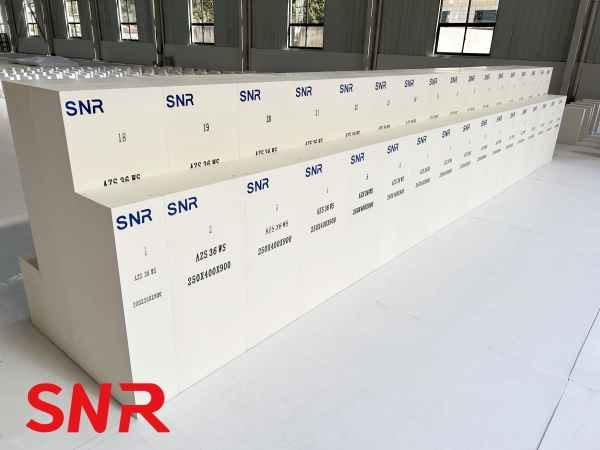
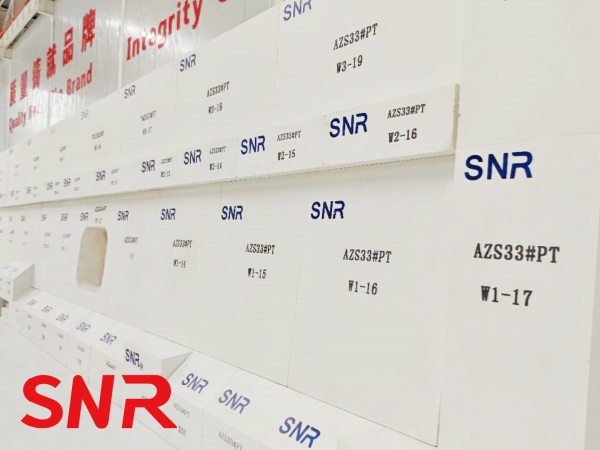
Thermal repair and damage control
For cracks and joint failures caused by the inward inclination, immediately use ceramic fiber mats + high alumina/AZS-based thermal repair materials for multi-layer filling to block the leakage path of high-temperature gas, protecting the external steel structure from overheating deformation; for areas with erosion and thinning, implement thermal spraying repair technology, spraying high adhesive AZS-based slurry to restore the thickness and strength of the structure, delaying the inward inclination process. Simultaneously optimize furnace operation: strictly and stably control the melting temperature (such as maintaining ≤1600℃ ± 5℃), maintain a slightly positive pressure environment (10-20 Pa), and adjust the flame shape to avoid direct impact on the breast wall, reducing the thermal load and chemical erosion rate from the source.
2. Performance and structural innovation strategies for fused cast AZS blocks
Preventing and delaying the inward inclination of the breast wall lies in improving the performance of fused cast AZS blocks and promoting technological innovation. Preventing and delaying the inward inclination of the breast wall lies in improving the performance of fused cast AZS blocks and promoting technological innovation. During construction, accurately calculate thermal expansion and reserve "step-like" expansion joints; use laser positioning and other technologies for construction, ensuring that the verticality error of the masonry is less than 0.1%.
3. Collaborative value and implementation path
►Short-term: Structural reinforcement and thermal repair can extend the furnace's service life by 1 to 2 years, providing time for planned cold shutdowns.
►Long-term: During the cold shutdown, using improved fused cast AZS blocks (such as composite prefabricated blocks) can increase the lifespan of the retaining wall by 30% to 50%, reduce the inclination rate by more than 70%, and significantly reduce unplanned shutdown losses.
►Core principle: For mild inclination, the focus is on reinforcement and maintenance; for severe deformation, a cold shutdown is required to replace the bricks and simultaneously correct the steel structure framework of the furnace.
Conclusion
The inward inclination of the breast wall is a typical structural defect in the later stages of the operation of glass furnaces. Its essence is the result of the long-term coupling effect of high-temperature creep, chemical erosion, thermal stress fatigue, and structural load. This deformation not only disrupts the mechanical balance of the furnace roof, triggering the risk of arch collapse, but also leads to sealing failure, increased energy consumption, fluctuations in glass quality, and a sharp reduction in furnace age. Fused cast AZS blocks have excellent resistance to erosion, creep, and thermal shock stability, making them the core materials for resisting the inward inclination of the breast wall. Through material composition optimization, structural innovation, and precise masonry techniques, the integrity of the breast wall structure can be significantly improved, reducing the inclination rate by more than 70%, extending the service life by 30% to 50%, and providing key guarantees for the safe, efficient, and long-term operation of the furnace.
Henan SNR Refractory Co., Ltd (SNR) produces a variety of high-quality fused cast AZS blocks. If you have any needs, please contact us.